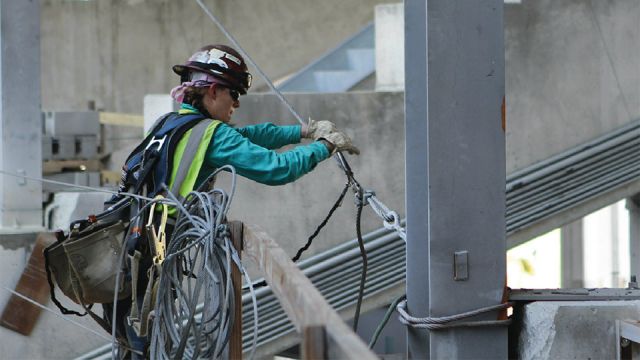Taking training to new heights
DFW International Airport’s approach to craft training
By Ryan Wilder
It’s no secret that the construction industry is facing a skilled workforce shortage, as employers on industrial and commercial projects struggle to find enough trained craft professionals to meet their needs. The Dallas/Fort Worth International Airport (DFW), which broke ground on a $2.3 billion renovation project in February 2011, decided to go with a proven approach to meet their workforce development needs: cents-per-hour funding.
The project, dubbed the Terminal Renewal and Improvement Program (TRIP), will involve renovating four terminals; building a new parking structure and transit station; enhancing roadway and concession space; and reconfiguring security checkpoints. As an owner focused on training and productivity, DFW partnered with the Construction Education Foundation (CEF) of North Texas to manage and distribute training funds and offer NCCER craft training to those companies that do not have training programs. The airport will contribute a set amount for every man hour worked into each contractor’s training account housed by the Foundation.
And, as one might expect at an airport that ranks as the world’s fourth largest in size of operations and eighth largest in terms of passengers carried, the number of skilled craft professionals needed to renovate the facility is substantial. Airport officials estimate that roughly 2500 skilled craft professionals will be needed over the life of the project, which is expected to last until 2017. Nearly 70 percent of the improvements taking place in the terminals are related to upgrading mechanical, electrical and plumbing systems.
“We have projects ranging from typical roadways to specialized areas like electrical and plumbing,” said Perfecto Solis, vice president of airport development engineering. “Being in North Texas, there are so many projects underway, creating a huge demand for a highly skilled workforce on both the TRIP project and the region in general.”
Why Cents-Per-Hour Made Sense
Having had great success with a centsper- hour approach to workforce development during the previous construction of Terminal D and a new “people mover” rail system inside DFW from 2000-2005, the decision to deploy that model again was an obvious choice for the airport.By investing in training, the airport hopes to benefit from a better trained workforce while helping to address the skilled workforce shortage in the region. “Hopefully, the implementation of this program will attract local companies as an additional incentive to working here at DFW,” said Julie Ludeman, director of communications for TRIP. “We feel confident that contractors will see this program as an opportunity to gain quality training for their employees.”
Ideally, the use of the cents-per-hour funding model will also benefit the community as a whole. Local contractors who are hired to work on the project will have the opportunity to have their craft professionals obtain training and earn industry-recognized credentials, which could increase the size of the skilled construction workforce in the area significantly.
“We feel like it’s our responsibility to give back to the community,” said Solis. “We learned from the previous capital development program that training our craft workers was successful and warranted. It only made sense to implement a similar training model on this program.”
In addition, the cents-per-hour funding model provides an avenue for contractors to pass training opportunities on to their subcontractors.
“As the mechanical contractor employing over 200 partners on this project, we are extremely appreciative of the [training program DFW is funding],” said Ben Houston, project executive for a mechanical joint venture contractor group. “We will be offering this training not only to our own employees, but to the employees of our 35 small and minority subcontractors, who normally would have difficulty providing this type of training.”
And, because DFW has other ongoing projects in the area, the airport expects that offering training will create a sense of loyalty among the contractors and subcontractors working on TRIP.
“As an owner offering a unique program, we feel that’s a competitive advantage,” said Tim Neathery, program administration manager for the airport.
Reaping the Benefits of Craft Training
Industry research has shown that stakeholders at all levels of industrial and commercial projects reap the benefits of formal craft training. A 2007 study by the Construction Industry Institute (CII) entitled Construction Industry Craft Training in the United States and Canada, which analyzed the benefits and costs of construction craft training, found that employees who had completed training showed an increase in productivity, and a decrease in absenteeism, injuries, turnover and rework rates. The same study found that, for every dollar spent by employers to train craft workers to the certified plus level, the total return on investment for the employer ranged from $1.30 to $3.00.“We are committed to having a highly-trained workforce and we make training a priority for our employees,” said co-owner of Momentum Mechanical Mark Rutledge, whose company is an HVAC and sheet metal subcontractor on the TRIP project. “Craft training increases employee productivity, safety, and requires less on-site supervision, all of which have a positive impact on our company’s financial status.”
Considering the benefits, it’s no surprise that DFW saw the value in investing in craft training on the TRIP project. Aside from the benefit in ROI to the owner, the nearly 300 contractors working on the renovation also have a great opportunity to use training and certification programs as a tool to identify their strongest employees and keep them in-house. In that regard, the 2007 CII study found that companies who provide their workers training on a project are more likely to rehire them on subsequent projects, which, in turn, can help contractors reduce hiring costs.
“We used every available dollar allocated to us during the last such program that DFW ran and saw the value in doing so. We will certainly do the same this time,” said Luis Spinola, president/CEO of Azteca Enterprises, Inc., whose company is part of a joint venture, construction-manager-at-risk group on the project.
One important component of craft training programs that certainly appeals to all contractors is safety. Safety training reduces injuries and accidents on projects, therefore giving contractors lower incidence rates. Owners look for contractors with lower than average incident rates and EMRs as leading indicators of companies who work hard to build and maintain strong safety cultures.
“Delivering an accident free project is the goal of every prime contractor in the construction business,” said John Avila, president and CEO of Thos. S. Byrne, whose company is part of a joint venture, construction-manager-at-risk group on the project. “The inclusion of NCCER’s Core safety training in the craft training program sends a message to our workers, clients and the public that safety is of the utmost importance.”
NCCER’s Core curriculum covers basic construction safety topics and complies with OSHA-10 training requirements, while more specific safety training is embedded in all NCCER craft training curricula as well.
“Safety training has to be the backbone of every construction training program because safety impacts every other aspect of our work. With experience and training comes improved quality, productivity and, of course, safety,” said Spinola. “If an employee is trained on the right and wrong ways to complete a task, they will work safer, do better quality work and share their knowledge with others on the job site. We’ve found that construction professionals really do want safe and productive workplaces and, by their nature, love to share their experience with others.”
Not to be forgotten, the craft professionals who go through the training programs also enjoy a laundry list of benefits, including increased earning potential and the opportunity to earn industryrecognized, portable credentials. In fact, the 2007 CII study found that craft workers who achieve the NCCER Certified Plus designation receive an average of $2/hour more than uncertified workers in the same field.
“We believe training is a critical component in the growth and development of all our employees, so much so that we use it as a measurement tool each year during performance reviews,” said Martin Lehman, Project Executive for the MBJ3 construction management group. “Together with each employee, we set goals that incorporate training opportunities for their skill level that will be crucial to their career development.”
The Big Picture: How Cents- Per-Hour Funding Can Reshape Construction Workforce Development
While the benefits of cents-per-hour training to the DFW airport are apparent, the effects of creating an incentive to invest in standardized training have a much greater overall impact. With FMI estimating that the construction industry will need 1.5 million new skilled craft workers by 2014, programs like the one at DFW that encourage owner and contractor commitment to craft training are exactly what the industry needs.To help make the cents-per-hour funding model available to the entire industry, NCCER has developed The National Training Service Agreement (NTSA) to provide contractors nationwide with a means to fund craft training programs. Under the NTSA, contractors voluntarily contribute 16 cents per craft-labor hour to an individual account that NCCER establishes and maintains for the contractor. Thirteen cents is directly reimbursed to the contractor for approved training and workforce development expenditures; two cents support workforce development efforts and industry advancement of craft training; and one cent funds industry recruitment and image enhancement efforts.
For contractors who take advantage of the cents-per-hour funding model through the NTSA, the benefits include job costing of training expenses, independent third-party verification that a contractor is conducting training and a mechanism for contractors to meet owner training demands.
“The cents-per-hour funding model NCCER has set up through its NTSA program - if adopted nationwide - would have a bottomline impact on major construction projects, the skills of our workforce and the communities in which projects are built,” said Jane B. Hanna, president/executive director of CEF of North Texas. “Their program is really the gold standard for this funding model in our industry and is available to companies of all sizes in all parts of the country.”
So, while owners, contractors and craft professionals all have different things to gain from the use of cents-per-hour funding as a tool to facilitate craft training, one thing is clear: investing in training is a winning formula for the construction industry.
About the Author
Ryan Wilder is the Communications Manager for the National Center for Construction Education and Research.
This article was originally published in the Fall 2012 edition of NCCER’s The Cornerstone magazine (www.nccercornerstone.org/digital). This content has been republished with the permission of NCCER and the publisher.



















